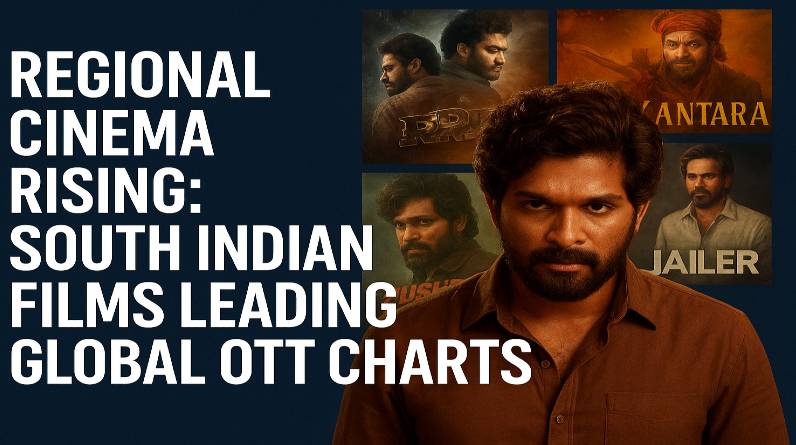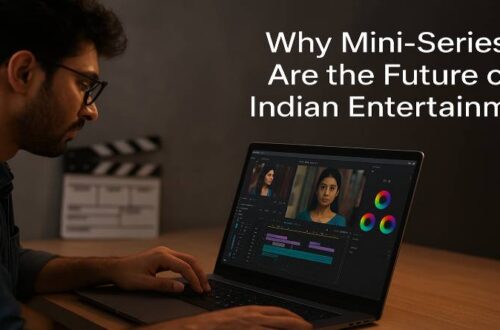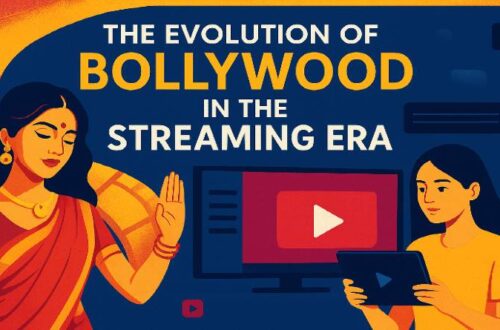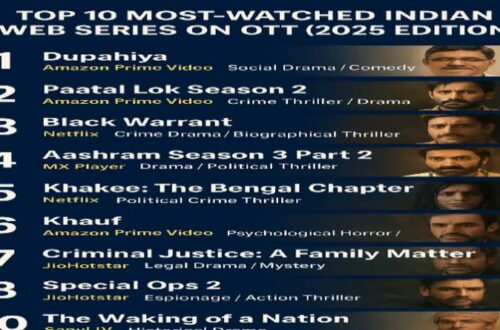The New Face of Indian Cinema
In the last few years, South Indian cinema has evolved from a regional powerhouse to a global cultural phenomenon. Tamil, Telugu, Malayalam, and Kannada films are not only topping Indian box office charts but are also dominating global OTT viewership rankings on platforms like Netflix, Amazon Prime Video, and Aha.
This rise marks a defining moment in Indian entertainment — one where authentic storytelling, cultural confidence, and digital access converge to rewrite the rules of success.
The OTT Revolution: Breaking Language Barriers
The surge of OTT platforms has been the most significant catalyst behind this transformation. Platforms such as Netflix, Amazon Prime, Disney+ Hotstar, Aha, and Hoichoi have dismantled the long-standing barrier between regional and national audiences.
According to the FICCI-EY M&E Report 2024, regional language streaming content in India grew from 27% in 2020 to 54% in 2024, signaling a massive shift in viewing habits. Viewers across India and abroad now watch films subtitled or dubbed in multiple languages — and 72% of Indian audiences reportedly consume content in a language they don’t speak, per YouGov data.
Why OTT Changed Everything
- Accessibility: Audiences from Delhi to New York can stream Malayalam thrillers or Tamil dramas instantly.
- Affordability: Subscription models made regional content accessible to middle-class and international viewers.
- Algorithmic visibility: OTT recommendations highlight trending regional titles, boosting cross-language discovery.
- Subtitles and dubbing: These have turned local stories into pan-Indian and global hits.
South Indian Cinema’s Box Office and Streaming Boom
The Ormax Box Office Report 2024 revealed that India’s total box office collection hit ₹11,833 crore — and South Indian industries contributed more than 45% of that total.
| Language | 2024 Market Share | Approx. Revenue (₹ Crore) |
| Telugu | 20% | 1,600–1,700 |
| Tamil | 15% | 1,200–1,300 |
| Malayalam | 10% | 1,000+ |
| Kannada | 8% | 850+ |
| Hindi (Bollywood) | 40% (down from 44% in 2023) | — |
The data shows what many suspected — South Indian cinema has overtaken Bollywood, not just at home but also across digital platforms.
Major global OTT charts in 2024–2025 list multiple South Indian titles among the Top 10 most-streamed Indian films, including Pushpa: The Rise, RRR, Kantara, Manjummel Boys, Kalki 2898 AD, and Jailer.
The “Dubbing Dividend” and Pan-India Appeal
One of the most fascinating trends in recent years is what experts call the “dubbing dividend.” Bollywood’s reported box-office growth often comes from dubbed South Indian films, not original Hindi productions.
- Pushpa 2’s Hindi-dubbed version alone earned ₹889 crore by mid-2025.
- Dubbed South Indian films accounted for 31% of Hindi cinema’s total revenue in 2024.
This suggests that South Indian stories are driving national engagement — and Bollywood’s numbers are increasingly riding on southern creativity.
Studios Redefining Regional Power
South Indian production houses have become national and global power centers.
1. Hombale Films (Kannada)
Founded by Vijay Kiragandur, Hombale is behind iconic hits like KGF: Chapter 1 & 2 and Kantara, amassing over ₹2,400 crore in combined box office revenue. With a focus on storytelling rooted in Kannada culture yet accessible globally, Hombale is a model of creative ambition meeting commercial success.
2. Mythri Movie Makers (Telugu)
Known for Pushpa 2: The Rule, Mathu Vadalara 2, and Jaat, Mythri has mastered the balance between mass spectacle and artistic integrity. In 2024, its slate grossed between ₹1,642–1,800 crore globally.
3. Sun Pictures (Tamil)
Backed by the Sun TV Network, Sun Pictures continues to dominate with films like Jailer and Leo, combining star power, cultural depth, and international marketing.
These studios’ business models — multilingual releases, OTT partnerships, and large-scale storytelling — have positioned them ahead of many Bollywood banners in both earnings and influence.
Audiences Demand Authenticity
Modern audiences crave stories that feel authentic and rooted, rather than formulaic or glamorous. This shift has benefited regional cinema immensely.
South Indian films often explore:
- Mythology and spirituality (Kantara, Kalki 2898 AD)
- Local folklore and social realism (Manjummel Boys, Drishyam)
- Strong moral and emotional narratives (RRR, Sita Ramam)
These themes resonate universally while staying grounded in their native cultures.
“Viewers no longer chase language — they chase great stories.”
Globalization of Regional Cinema
From Theatres to Worldwide Screens
Before 2015, only a handful of South Indian films were dubbed into Hindi each year. Now, over 50 titles receive multilingual releases annually.
Films like RRR and KGF: Chapter 2 achieved unprecedented success, grossing over ₹1,000 crore worldwide, while earning accolades in the U.S., Japan, and the U.K.
The OTT Effect on Global Reach
- Manjummel Boys and Jallikattu became top-ranked films on international Netflix charts.
- Kantara trended simultaneously in 17 countries.
- Kalki 2898 AD (Telugu) achieved one of the highest non-Hindi viewership rates ever recorded on Prime Video India.
Bollywood’s Adaptive Response
Bollywood has recognized that the rise of South cinema is not a passing trend but a structural shift. To stay competitive, major studios are now:
- Investing in regional projects — Dharma Productions and T-Series are producing Marathi, Tamil, and Punjabi films.
- Collaborating with Southern stars — Deepika Padukone, Alia Bhatt, and Ajay Devgn headline Telugu and Kannada blockbusters.
- Acquiring remake rights — Classic model replaced by co-production partnerships and pan-India releases.
This cross-pollination has blurred industry boundaries, giving rise to a truly “Indian cinema” rather than separate regional or Hindi industries.
Policy Support and Industry Reforms
State governments are recognizing the economic and cultural value of regional cinema. Initiatives include:
- New Film Tourism Policies (e.g., GIS Bhopal) offering up to ₹10 crore in subsidies for local productions.
- Grants and incentives for Marathi, Malayalam, and Assamese filmmakers.
- Piracy protection drives and single-window clearances for film shoots.
Such policies have strengthened infrastructure and encouraged regional OTT startups like Planet Marathi to scale rapidly (500% subscriber growth in 2024).
Challenges Ahead
Despite its success, regional cinema faces ongoing challenges:
- Funding inequality — Small creators struggle while big studios dominate financing.
- Distribution gaps — Multiplex bias toward Hindi and Hollywood films limits screens for regional movies.
- Piracy losses — Particularly harmful to low-budget regional releases.
- Rural access decline — Closure of single-screen theatres has reduced reach in small towns.
Addressing these issues will be key to sustaining the momentum of regional storytelling.
India’s Cultural Renaissance on Screen
The rise of South Indian cinema is not just a business story — it’s a cultural renaissance. For decades, Bollywood defined what Indian cinema looked like to the world. Now, regional films are reclaiming that narrative by representing India’s true diversity, one language at a time.
This shift signals the decentralization of Indian entertainment — a move from Mumbai’s monopoly to a multi-centered ecosystem powered by Chennai, Hyderabad, Kochi, and Bengaluru.
What’s next? Experts predict the next global breakthrough will come not from Hindi but from a subtitled regional film that wins both hearts and awards — much like Parasite did for South Korea.
Conclusion
South Indian cinema’s rise marks the dawn of a new Indian film era — multilingual, inclusive, global, and fearless. Backed by OTT platforms, digital audiences, and visionary filmmakers, regional cinema is no longer the “other” industry; it’s the main stage of India’s cinematic identity.
The next time a Telugu or Tamil film tops Netflix’s global charts, it won’t be surprising — it’ll simply confirm what the world already knows: regional is the new universal.
FAQs
- Why are South Indian films dominating global OTT charts?
South Indian films combine strong storytelling, high production quality, and cultural authenticity. OTT platforms have expanded their reach beyond regional boundaries, attracting global audiences through subtitles and dubbing. - Which South Indian films have achieved international success?
Blockbusters like RRR, Kantara, Pushpa: The Rise, Kalki 2898 AD, Jailer, and Manjummel Boys have topped international streaming and box office charts, highlighting the global appeal of regional cinema. - How have OTT platforms boosted regional cinema’s visibility?
Streaming platforms such as Netflix, Amazon Prime Video, and Aha have enabled multilingual access. Algorithms now promote regional titles alongside Hindi and Hollywood releases, helping them trend globally. - What role do production houses play in South cinema’s success?
Studios like Hombale Films, Mythri Movie Makers, and Sun Pictures invest heavily in storytelling, scale, and multilingual releases, making regional films competitive on a national and international level. - How has Bollywood responded to the rise of South Indian cinema?
Bollywood studios now collaborate with South Indian filmmakers, co-produce multilingual projects, and cast Southern stars to stay relevant in India’s evolving entertainment landscape. - What challenges does regional cinema still face?
Funding inequality, piracy, and limited distribution in multiplexes continue to hinder smaller regional productions despite the industry’s growing global influence. - What is the future of South Indian cinema in global entertainment?
Analysts predict regional Indian films will soon achieve the kind of global acclaim that Korean or Japanese cinema enjoys, cementing South India’s position as a creative hub for international storytelling.





